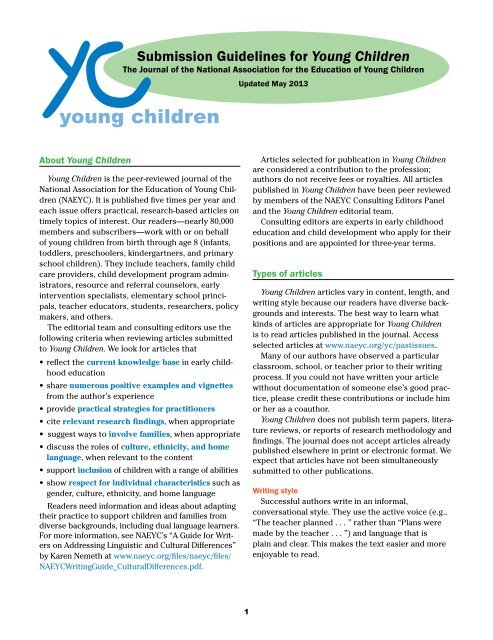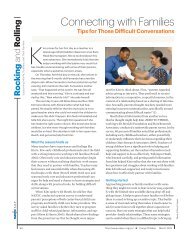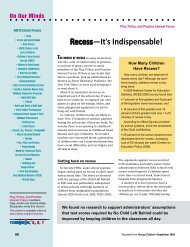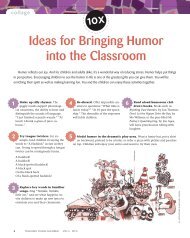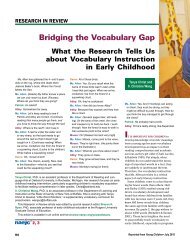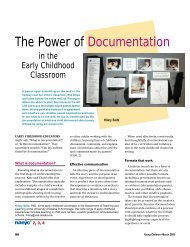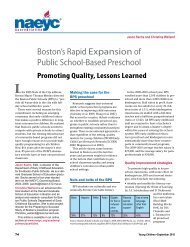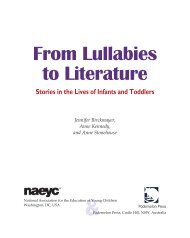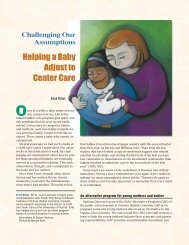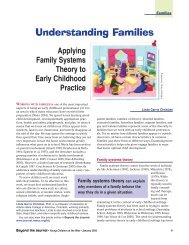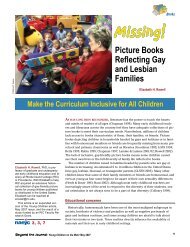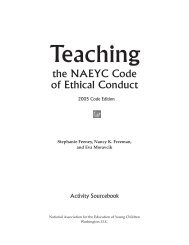young children - National Association for the Education of Young ...
young children - National Association for the Education of Young ...
young children - National Association for the Education of Young ...
Create successful ePaper yourself
Turn your PDF publications into a flip-book with our unique Google optimized e-Paper software.
Submission Guidelines <strong>for</strong> <strong>Young</strong> Children<br />
The Journal <strong>of</strong> <strong>the</strong> <strong>National</strong> <strong>Association</strong> <strong>for</strong> <strong>the</strong> <strong>Education</strong> <strong>of</strong> <strong>Young</strong> Children<br />
<strong>young</strong> <strong>children</strong><br />
Updated May 2013<br />
About <strong>Young</strong> Children<br />
<strong>Young</strong> Children is <strong>the</strong> peer-reviewed journal <strong>of</strong> <strong>the</strong><br />
<strong>National</strong> <strong>Association</strong> <strong>for</strong> <strong>the</strong> <strong>Education</strong> <strong>of</strong> <strong>Young</strong> Children<br />
(NAEYC). It is published five times per year and<br />
each issue <strong>of</strong>fers practical, research-based articles on<br />
timely topics <strong>of</strong> interest. Our readers—nearly 80,000<br />
members and subscribers—work with or on behalf<br />
<strong>of</strong> <strong>young</strong> <strong>children</strong> from birth through age 8 (infants,<br />
toddlers, preschoolers, kindergartners, and primary<br />
school <strong>children</strong>). They include teachers, family child<br />
care providers, child development program administrators,<br />
resource and referral counselors, early<br />
intervention specialists, elementary school principals,<br />
teacher educators, students, researchers, policy<br />
makers, and o<strong>the</strong>rs.<br />
The editorial team and consulting editors use <strong>the</strong><br />
following criteria when reviewing articles submitted<br />
to <strong>Young</strong> Children. We look <strong>for</strong> articles that<br />
• reflect <strong>the</strong> current knowledge base in early childhood<br />
education<br />
• share numerous positive examples and vignettes<br />
from <strong>the</strong> author’s experience<br />
• provide practical strategies <strong>for</strong> practitioners<br />
• cite relevant research findings, when appropriate<br />
• suggest ways to involve families, when appropriate<br />
• discuss <strong>the</strong> roles <strong>of</strong> culture, ethnicity, and home<br />
language, when relevant to <strong>the</strong> content<br />
• support inclusion <strong>of</strong> <strong>children</strong> with a range <strong>of</strong> abilities<br />
• show respect <strong>for</strong> individual characteristics such as<br />
gender, culture, ethnicity, and home language<br />
Readers need in<strong>for</strong>mation and ideas about adapting<br />
<strong>the</strong>ir practice to support <strong>children</strong> and families from<br />
diverse backgrounds, including dual language learners.<br />
For more in<strong>for</strong>mation, see NAEYC’s “A Guide <strong>for</strong> Writers<br />
on Addressing Linguistic and Cultural Differences”<br />
by Karen Nemeth at www.naeyc.org/files/naeyc/files/<br />
NAEYCWritingGuide_CulturalDifferences.pdf.<br />
Articles selected <strong>for</strong> publication in <strong>Young</strong> Children<br />
are considered a contribution to <strong>the</strong> pr<strong>of</strong>ession;<br />
authors do not receive fees or royalties. All articles<br />
published in <strong>Young</strong> Children have been peer reviewed<br />
by members <strong>of</strong> <strong>the</strong> NAEYC Consulting Editors Panel<br />
and <strong>the</strong> <strong>Young</strong> Children editorial team.<br />
Consulting editors are experts in early childhood<br />
education and child development who apply <strong>for</strong> <strong>the</strong>ir<br />
positions and are appointed <strong>for</strong> three-year terms.<br />
Types <strong>of</strong> articles<br />
<strong>Young</strong> Children articles vary in content, length, and<br />
writing style because our readers have diverse backgrounds<br />
and interests. The best way to learn what<br />
kinds <strong>of</strong> articles are appropriate <strong>for</strong> <strong>Young</strong> Children<br />
is to read articles published in <strong>the</strong> journal. Access<br />
selected articles at www.naeyc.org/yc/pastissues.<br />
Many <strong>of</strong> our authors have observed a particular<br />
classroom, school, or teacher prior to <strong>the</strong>ir writing<br />
process. If you could not have written your article<br />
without documentation <strong>of</strong> someone else’s good practice,<br />
please credit <strong>the</strong>se contributions or include him<br />
or her as a coauthor.<br />
<strong>Young</strong> Children does not publish term papers, literature<br />
reviews, or reports <strong>of</strong> research methodology and<br />
findings. The journal does not accept articles already<br />
published elsewhere in print or electronic <strong>for</strong>mat. We<br />
expect that articles have not been simultaneously<br />
submitted to o<strong>the</strong>r publications.<br />
Writing style<br />
Successful authors write in an in<strong>for</strong>mal,<br />
conversational style. They use <strong>the</strong> active voice (e.g.,<br />
“The teacher planned . . . ” ra<strong>the</strong>r than “Plans were<br />
made by <strong>the</strong> teacher . . . ”) and language that is<br />
plain and clear. This makes <strong>the</strong> text easier and more<br />
enjoyable to read.<br />
1
The following table indicates some preferred language.<br />
Use this . . . Instead <strong>of</strong> . . .<br />
development and learning growth and development<br />
dual language learner<br />
English language learner<br />
guidance<br />
discipline<br />
home language<br />
native language<br />
child care; preschool, school-based, daycare program<br />
center-based program; family child<br />
care program; or child development<br />
program<br />
use<br />
utilize<br />
In addition, avoid using <strong>the</strong> words should and must<br />
when describing teaching practices (“Teachers can<br />
engage <strong>children</strong> by . . .” versus “Teachers must engage<br />
<strong>children</strong> by . . .”).<br />
General feature articles (Note: An article proposal is<br />
not required, but see <strong>the</strong> “Formatting Requirements”<br />
section on page 3 <strong>for</strong> <strong>for</strong>matting guidelines.)<br />
These articles address important issues <strong>for</strong> <strong>the</strong><br />
early childhood community. Here are examples <strong>of</strong> <strong>the</strong><br />
types <strong>of</strong> articles found in <strong>Young</strong> Children.<br />
• Innovative, research-based teaching strategies. See<br />
example: http://journal.naeyc.org/btj/200503/03korte.<br />
pdf<br />
• Early childhood <strong>the</strong>ories and research, along with<br />
recommended practices. See example: http://journal.<br />
naeyc.org/btj/200309/Planning&Reflection.pdf<br />
• Specific issues affecting <strong>young</strong> <strong>children</strong>. See example:<br />
http://journal.naeyc.org/btj/200501/smith.pdf<br />
Cluster topic articles (Note: An article proposal is<br />
required.)<br />
Each issue includes a group <strong>of</strong> articles that consider<br />
different aspects <strong>of</strong> <strong>the</strong> same topic. Cluster topics<br />
are decided on many months in advance (see page 5).<br />
For an example <strong>of</strong> a cluster article go to www.naeyc.<br />
org/files/yc/file/201107/Self-Regulation_Florez_Online-<br />
July2011.pdf.<br />
<strong>Young</strong> Children requires authors to submit an<br />
article proposal be<strong>for</strong>e submitting a full article <strong>for</strong><br />
a cluster topic. This process provides authors with<br />
useful feedback from peer reviewers and editors<br />
be<strong>for</strong>e <strong>the</strong>y write and submit full-length articles. Not<br />
all authors are invited to submit full articles. The<br />
following steps describe <strong>the</strong> submission process <strong>for</strong><br />
cluster articles.<br />
1. Write and submit an article proposal. The<br />
author’s 2- to 3-page cluster proposal is due at least<br />
9 months prior to <strong>the</strong> cluster publication date. The<br />
proposal should include<br />
a. Intended audience <strong>for</strong> <strong>the</strong> article<br />
b. Why <strong>the</strong> topic is important <strong>for</strong> early childhood<br />
educators<br />
c. An outline <strong>of</strong> <strong>the</strong> topics to be addressed<br />
d. How one-third <strong>of</strong> <strong>the</strong> article will be devoted to<br />
practical strategies <strong>for</strong> practitioners<br />
e. A description <strong>of</strong> any tables, exhibits, or images that<br />
will accompany <strong>the</strong> article<br />
f. A reference list<br />
To submit proposals <strong>for</strong> cluster articles, use Manuscript<br />
Central at http://mc.manuscriptcentral.com/<br />
<strong>young</strong><strong>children</strong>. Each proposal will receive an ID<br />
number. Include <strong>the</strong> author(s) name, contact in<strong>for</strong>mation,<br />
affiliation, and a brief cover letter.<br />
2. Proposal review. Consulting editors and <strong>the</strong> <strong>Young</strong><br />
Children editorial team review <strong>the</strong> proposals. Editors<br />
provide feedback four to six weeks after <strong>the</strong> cluster<br />
proposal due date.<br />
3. Cluster article submission. <strong>Young</strong> Children’s<br />
editors invite selected authors to write and submit<br />
full-length articles that will undergo peer review.<br />
Please note that <strong>the</strong> invitation to write a cluster<br />
article does not guarantee acceptance. Authors<br />
whose proposals are not selected will be notified <strong>of</strong><br />
this decision. Cluster articles are due four months<br />
be<strong>for</strong>e <strong>the</strong> publication <strong>of</strong> <strong>the</strong> cluster.<br />
Periodic features<br />
In addition to cluster and general articles, <strong>Young</strong><br />
Children includes several periodic features. We accept<br />
submissions <strong>for</strong> <strong>the</strong>se features on an ongoing basis.<br />
• Viewpoint columns allow authors to express <strong>the</strong>ir<br />
research-based opinions about specific issues or<br />
practices. See example: http://journal.naeyc.org/<br />
btj/200507/02Neuman.pdf<br />
• Research in Review articles summarize research<br />
and describe implications <strong>for</strong> practice. Authors work<br />
with <strong>the</strong> journal’s Research in Review editors. For<br />
more in<strong>for</strong>mation, contact Derry Koralek, Editor in<br />
Chief/Chief Publishing Officer. See example: http://<br />
journal.naeyc.org/btj/200309/DelayingKEntry.pdf<br />
2
Formatting requirements<br />
When submitting an article to <strong>Young</strong> Children,<br />
please adhere to <strong>the</strong> <strong>for</strong>matting and submission<br />
guidelines.<br />
Length<br />
All manuscripts must meet page-length requirements:<br />
• General and cluster articles and Viewpoints are<br />
from 3–12 pages, double-spaced, including references<br />
and visuals. Our readers find articles 3–9 pages in<br />
length most useful; <strong>the</strong>se shorter articles tend to be<br />
published more quickly.<br />
Format<br />
If manuscripts are not <strong>for</strong>matted correctly, <strong>the</strong>y will<br />
be unsubmitted until <strong>the</strong> appropriate changes are<br />
made.<br />
• Make sure <strong>the</strong> name(s) <strong>of</strong> <strong>the</strong> author(s) does not<br />
appear on any page <strong>of</strong> <strong>the</strong> article; all manuscripts are<br />
subject to blind review.<br />
• Use pseudonyms instead <strong>of</strong> <strong>children</strong>’s real names.<br />
• Include headings and subheadings throughout <strong>the</strong><br />
article. (Make sure <strong>the</strong> headings do not contain in<strong>for</strong>mation<br />
that could identify <strong>the</strong> author to reviewers.)<br />
• Use Times New Roman font, 12-point type, doublespaced<br />
lines, and at least one-inch margins.<br />
• Number <strong>the</strong> pages.<br />
• Include <strong>the</strong> title and date in <strong>the</strong> footer.<br />
Cover letter<br />
• Prepare <strong>the</strong> cover letter as a separate document.<br />
• List <strong>the</strong> title.<br />
• Indicate <strong>the</strong> type <strong>of</strong> article (cluster topic, general,<br />
Viewpoint, and so on).<br />
• List <strong>the</strong> name, affiliation, title, address, phone, fax,<br />
and e-mail <strong>for</strong> each author.<br />
• Designate one author as <strong>the</strong> primary contact.<br />
• Give <strong>the</strong> Manuscript ID <strong>for</strong> any manuscript written<br />
by a primary author or coauthor that was accepted<br />
<strong>for</strong> publication or published in <strong>Young</strong> Children within<br />
<strong>the</strong> last two years.<br />
• Provide a brief summary <strong>of</strong> how one-third <strong>of</strong> <strong>the</strong><br />
text <strong>of</strong>fers useful and relevant in<strong>for</strong>mation <strong>for</strong><br />
teachers and o<strong>the</strong>r practitioners.<br />
Style guides<br />
Authors should provide accurate and complete<br />
in<strong>for</strong>mation <strong>for</strong> references and resources. <strong>Young</strong><br />
Children expects authors to focus on references<br />
published within <strong>the</strong> last 10 years in order to reflect<br />
<strong>the</strong> most recent research and data. Authors should<br />
also use <strong>the</strong> number <strong>of</strong> resources appropriate <strong>for</strong> <strong>the</strong><br />
length <strong>of</strong> <strong>the</strong>ir manuscript.<br />
<strong>Young</strong> Children follows Merriam-Webster’s Collegiate<br />
Dictionary, 11th edition, <strong>for</strong> spelling and The Chicago<br />
Manual <strong>of</strong> Style, 16th edition, <strong>for</strong> style and reference<br />
<strong>for</strong>matting, especially Chapter 15, “Documentation II.”<br />
For more in<strong>for</strong>mation, visit www.m-w.com or www.<br />
chicagomanual<strong>of</strong>style.org.<br />
Visuals<br />
We encourage authors to include in<strong>for</strong>mative,<br />
interesting visuals (e.g., high-resolution photographs,<br />
<strong>children</strong>’s work samples, charts, graphs) that<br />
enhance <strong>the</strong> content <strong>of</strong> <strong>the</strong> article and promote<br />
understanding. This is not a requirement.<br />
Prior to submission, <strong>the</strong> author must possess<br />
completed model release <strong>for</strong>ms <strong>for</strong> any recognizable<br />
person appearing in <strong>the</strong> author’s photos (signed by<br />
any adult who appears in <strong>the</strong> photo and by <strong>the</strong> legal<br />
guardian <strong>of</strong> any child who appears in <strong>the</strong> photo). If<br />
<strong>the</strong> author did not take <strong>the</strong> photos but submits <strong>the</strong>m<br />
with <strong>the</strong> article, <strong>the</strong> author must confirm that she or<br />
he has <strong>the</strong> right to publish <strong>the</strong> photos and that <strong>the</strong><br />
photographer possesses <strong>the</strong> necessary model releases.<br />
One sample model release and <strong>the</strong> visuals<br />
<strong>the</strong>mselves should be uploaded as separate files<br />
in Manuscript Central as part <strong>of</strong> <strong>the</strong> manuscript<br />
submission. Do not include <strong>the</strong>m in <strong>the</strong> body <strong>of</strong> <strong>the</strong><br />
article. <strong>Young</strong> Children does not pay authors <strong>for</strong> <strong>the</strong>ir<br />
own photos when <strong>the</strong>y are integral to <strong>the</strong> content <strong>of</strong><br />
<strong>the</strong> article.<br />
To make a photograph submission, please see<br />
our photography guidelines at www.naeyc.org/<br />
publications/<strong>for</strong>authors/photoguidelines.<br />
Permissions<br />
Authors are responsible <strong>for</strong> seeking and maintaining<br />
written permission from parents or legal guardians<br />
to include <strong>children</strong>’s art and work samples.<br />
NAEYC may request to review <strong>the</strong>se permissions.<br />
For quoted material longer than 100 words, authors<br />
must seek and submit to <strong>Young</strong> Children written permission<br />
from <strong>the</strong> copyright holder prior to publication.<br />
3
How to submit an article<br />
<strong>Young</strong> Children receives all submissions through<br />
Manuscript Central at http://mc.manuscriptcentral.<br />
com/<strong>young</strong><strong>children</strong>. After creating an account,<br />
authors will find instructions <strong>for</strong> manuscript<br />
submission. Be sure to submit <strong>the</strong> cover letter,<br />
article, and photographs as separate files. Authors<br />
can contact Manuscript Central <strong>for</strong> assistance or<br />
e-mail <strong>the</strong> <strong>Young</strong> Children editorial staff at editorial@<br />
naeyc.org.<br />
With <strong>the</strong> exception <strong>of</strong> articles <strong>for</strong> clusters, articles<br />
are generally published 12 to 24 months after acceptance.<br />
Authors may check <strong>the</strong> status <strong>of</strong> <strong>the</strong>ir submissions<br />
in Manuscript Central by logging in and clicking<br />
on <strong>the</strong> “Submitted Manuscripts” link on <strong>the</strong> left side<br />
<strong>of</strong> <strong>the</strong> dashboard.<br />
Description <strong>of</strong> <strong>the</strong> process<br />
Please note: Individuals may submit only one<br />
article within a six-month period. <strong>Young</strong> Children’s<br />
preferred practice is to publish a particular author<br />
only once within a 12-month period. On rare occasions<br />
we make exceptions to best meet <strong>the</strong> needs <strong>of</strong><br />
our readers.<br />
Authors may submit only one article at a time. This<br />
holds true whe<strong>the</strong>r <strong>the</strong>y are <strong>the</strong> only author, or one<br />
<strong>of</strong> several. If authors have written several articles <strong>for</strong><br />
submission, <strong>the</strong>y must decide which one to submit first.<br />
After <strong>the</strong> article has been reviewed, <strong>the</strong> author will<br />
be notified <strong>of</strong> its status. After receipt <strong>of</strong> this notification,<br />
<strong>the</strong> author may submit ano<strong>the</strong>r article. Thus,<br />
only one article per author can be under initial<br />
consideration and review at a time.<br />
Review and editing process<br />
The <strong>Young</strong> Children review process generally takes<br />
six to eight months from receipt <strong>of</strong> a manuscript.<br />
The process is compressed <strong>for</strong> cluster articles. The<br />
schedule may vary according to <strong>the</strong> schedule <strong>of</strong> our<br />
reviewers, many <strong>of</strong> whom are on <strong>the</strong> academic calendar.<br />
The review and editing steps are explained in <strong>the</strong><br />
following table.<br />
Time frame<br />
1 Initial reading.<br />
Given <strong>the</strong> volume <strong>of</strong> articles we receive, not all articles can be sent out <strong>for</strong> review nor can we provide individual feedback<br />
on articles that are not reviewed. The editor in chief/chief publishing <strong>of</strong>ficer determines whe<strong>the</strong>r articles will go<br />
out <strong>for</strong> review. There are a number <strong>of</strong> reasons why articles are not sent out <strong>for</strong> review. Sometimes articles do not meet<br />
basic guidelines <strong>for</strong> content, writing style, length, or <strong>for</strong>mat. At times, <strong>the</strong> journal has a backlog <strong>of</strong> articles or has recently<br />
published an article on <strong>the</strong> same topic. In some cases, we receive a number <strong>of</strong> proposals <strong>for</strong> a cluster that address <strong>the</strong><br />
same topic and age group. The editor in chief/chief publishing <strong>of</strong>ficer might recommend revising an article be<strong>for</strong>e it is<br />
considered <strong>for</strong> review by consulting editors.<br />
2 Peer review.<br />
Articles that meet basic guidelines undergo peer review by members <strong>of</strong> NAEYC’s Consulting Editors Panel. The<br />
reviewers provide comments and suggestions. NAEYC senior staff may also review articles.<br />
3 Decision.<br />
Using all reviews as a guide, <strong>the</strong> editorial team determines one <strong>of</strong> <strong>the</strong> following as <strong>the</strong> next step:<br />
• Accept <strong>the</strong> article.<br />
• Ask <strong>the</strong> author to make revisions and resubmit it <strong>for</strong> fur<strong>the</strong>r review (most articles require some revision) and<br />
possible acceptance.<br />
• Advise <strong>the</strong> author that <strong>the</strong> article is not accepted.<br />
The editor in chief/chief publishing <strong>of</strong>ficer notifies <strong>the</strong> author <strong>of</strong> <strong>the</strong> decision via e-mail. When necessary, this<br />
correspondence includes <strong>the</strong> reviewers’ feedback and suggestions <strong>for</strong> enhancing <strong>the</strong> manuscript.<br />
4 Revision.<br />
When authors submit revised articles, <strong>the</strong>y must include a summary <strong>of</strong> what <strong>the</strong>y did to address <strong>the</strong> reviewers’<br />
feedback, through Manuscript Central.<br />
12–16 weeks<br />
after receipt<br />
16–20 weeks<br />
after receipt<br />
20–26 weeks<br />
after receipt<br />
Within 6 months<br />
<strong>of</strong> authors’ receipt<br />
<strong>of</strong> decision e-mail<br />
4
After revisions<br />
Members <strong>of</strong> <strong>the</strong> editorial team read <strong>the</strong> revised<br />
manuscript, consider <strong>the</strong> author’s responses to <strong>the</strong><br />
reviewers’ feedback and suggestions, and determine<br />
one <strong>of</strong> <strong>the</strong> following as <strong>the</strong> next step:<br />
• Accept <strong>the</strong> article.<br />
• Ask <strong>the</strong> author to make additional revisions.<br />
• Advise <strong>the</strong> author that <strong>the</strong> manuscript still does not<br />
meet criteria <strong>for</strong> publication in <strong>Young</strong> Children.<br />
From acceptance to print<br />
It is not possible to determine in advance <strong>the</strong> exact<br />
publication dates <strong>of</strong> accepted articles (unless <strong>the</strong>y<br />
are accepted <strong>for</strong> a particular cluster). When planning<br />
issues, <strong>the</strong> editorial team considers <strong>the</strong> content, style,<br />
intended audience, and length <strong>of</strong> articles, as well as<br />
articles’ submission dates.<br />
Authors are notified when <strong>the</strong>ir articles are<br />
scheduled <strong>for</strong> publication. They are asked to make<br />
updates and to complete biographies, copyright<br />
transfer, and photograph submission and credit<br />
<strong>for</strong>ms.<br />
Editing involves <strong>the</strong> editorial and copy editing<br />
teams. The copy editor returns <strong>the</strong> edited article to<br />
<strong>the</strong> author via e-mail <strong>for</strong> final approval be<strong>for</strong>e <strong>the</strong><br />
manuscript enters production. On occasion, lastminute<br />
changes in an issue’s content may cause<br />
publication <strong>of</strong> an article to be postponed.<br />
Authors receive two copies <strong>of</strong> <strong>the</strong> issue in which<br />
<strong>the</strong>ir article appears.<br />
<strong>Young</strong> Children Cluster Topics <strong>for</strong> 2014<br />
Issue Date Cluster Topic Proposals Due Article Due Date<br />
September 2013<br />
November 2013<br />
Physical Environments That Engage and Inspire<br />
<strong>Young</strong> Learners<br />
Positive Guidance in <strong>the</strong> Early Years: Using<br />
Developmentally Appropriate Strategies<br />
Not accepting new<br />
submissions<br />
Not accepting new<br />
submissions<br />
March 2014 Real Stories From Real Classrooms Not accepting new<br />
submissions<br />
May 2014 Play in <strong>the</strong> Early Childhood Years August 1, 2013 December 1, 2013<br />
N/A<br />
N/A<br />
N/A<br />
July 2014 Language and Literacy Not accepting new<br />
submissions<br />
September 2014 Engaging Families December 1, 2013 April 1, 2014<br />
N/A<br />
November 2014 Nutrition and Fitness <strong>for</strong> All <strong>Young</strong> Children Not accepting new<br />
submissions<br />
N/A<br />
Derry Koralek<br />
Editor in Chief/<br />
Chief Publishing<br />
Officer<br />
Contact In<strong>for</strong>mation<br />
Amy Shillady<br />
Journal Editor<br />
Mabel Yu<br />
Assistant Editor<br />
202-232-8777, ext. 8417<br />
myu@naeyc.org<br />
<strong>National</strong> <strong>Association</strong> <strong>for</strong> <strong>the</strong> <strong>Education</strong> <strong>of</strong> <strong>Young</strong> Children<br />
1313 L Street, NW, Suite 500 Washington, DC 20005<br />
www.naeyc.org<br />
e-mail: editorial@naeyc.org
<strong>Young</strong> Children Submission Quick Tips<br />
<strong>young</strong> <strong>children</strong><br />
Writing<br />
• Write in <strong>the</strong> active voice using plain language. This makes <strong>the</strong> text clearer <strong>for</strong> readers.<br />
• Focus on references published within <strong>the</strong> last 10 years.<br />
Formatting<br />
• Use Times New Roman font, 12-point type, double-spaced, and 1-inch margins.<br />
• References and tables count toward <strong>the</strong> 12-page manuscript limit; visuals do not.<br />
• In your cover letter, be sure to explain how one-third <strong>of</strong> <strong>the</strong> article is devoted to in<strong>for</strong>mation <strong>for</strong> practitioners.<br />
• Upload visuals separately from <strong>the</strong> manuscript. Don’t paste photographs or work examples into <strong>the</strong> manuscript.<br />
Cluster proposal<br />
• Include items a–f as described in <strong>the</strong> submission guidelines.<br />
• Keep <strong>the</strong> proposal to 2–3 pages.<br />
Using Manuscript Central<br />
• Upload your cover page, manuscript, and photographs as separate items.<br />
• To submit a revision, click on <strong>the</strong> purple star that says “Click here to make a revision.”<br />
• When submitting a manuscript based on a proposal, submit it as a revision <strong>of</strong> <strong>the</strong> proposal.<br />
Deadlines<br />
• We hold fast to our submission deadlines <strong>for</strong> cluster proposals and articles. If you miss a cluster deadline,<br />
you can submit your article as a general article <strong>for</strong> a future issue.<br />
The review process<br />
• The editing process takes several months. Expect a decision approximately 6–8 months after submitting your<br />
manuscript.<br />
• Track <strong>the</strong> progress <strong>of</strong> your manuscript in your Author Center in Manuscript Central. This will tell you if <strong>the</strong><br />
manuscript is waiting to be sent out to reviewers, if it is waiting <strong>for</strong> reviewer scores, or if it is waiting <strong>for</strong> <strong>the</strong><br />
decision <strong>of</strong> <strong>the</strong> editor in chief/chief publishing <strong>of</strong>ficer.<br />
Questions?<br />
If you have any questions about cluster topics, submitting your manuscript, or Manuscript Central, please contact<br />
Mabel Yu at myu@naeyc.org or 202-232-8777, ext. 8417.<br />
Interested in writing <strong>for</strong> o<strong>the</strong>r NAEYC publications?<br />
Check out our author guidelines <strong>for</strong>: Books, For Families website, Teaching <strong>Young</strong> Children, and Voices <strong>of</strong> Practitioners<br />
6


